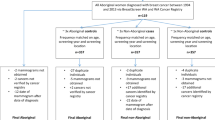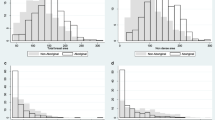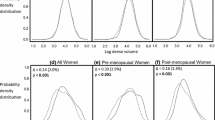Abstract
Objectives
To compare the mammographic densities and other characteristics of Aboriginal and non-Aboriginal women screened in Australia.
Methods
Population screening programme data of Aboriginal (n = 857) and non-Aboriginal women (n = 3236) were used. Mann–Whitney U test compared ages at screening and Chi-square tests compared personal and clinical information. Logistic regression analysis was used for density groupings. OR and 95% CI were calculated for multivariate association for density.
Results
Mammographic density was lower amongst Aboriginal women (P < 0.001). For non-Aboriginal women, higher density was associated with younger age (OR 2.4, 95% CI 2.1–2.8), recall to assessment (OR 2.2, 95% CI 1.6–3.0), family history of breast cancer (OR 1.4, 95% CI 1.2–1.6), English-speaking background (OR 1.4, 95% CI 1.2–1.6), and residence in remote areas (OR 1.2, 95% CI 1.1–1.4). For Aboriginal women, density was associated with younger age (OR 2.7, 95% CI 2.0–3.5; P < 0.001), and recall to assessment (OR 2.3, 95% CI 1.4–3.9; P < 0.05).
Conclusions
Significant differences between Aboriginal and non-Aboriginal women were found. There were more significant associations for dense breasts for non-Aboriginal women than for Aboriginal women.


Similar content being viewed by others
References
Al Mousa DS et al (2014) Mammographic density and cancer detection: does digital imaging challenge our current understanding? Acad Radiol 21:1377–1385. https://doi.org/10.1016/j.acra.2014.06.004
Australian Bureau of Statistics (2011a) 1270.0.55.005—Australian Statistical Geography Standard (ASGS): volume 5—Remoteness structure, 2011, Canberra
Australian Bureau of Statistics (2011b) 2075.0—Census of population and housing: counts of Aboriginal and Torres Strait Islander Australians, 2011. ABS, Canberra
Australian Bureau of Statistics (2013) 4727.0.55.001—Australian Aboriginal and Torres Strait Islander health survey: first results, Australia, 2012–2013. ABS, Canberra
Australian Institute of Health and Welfare (2012) Breast cancer in Australia: an overview. AIHW, Canberra
Australian Institute of Health and Welfare (2015a) BreastScreen Australia monitoring report 2012–2013. AIHW, Canberra
Australian Institute of Health and Welfare (2015b) The health and welfare of Australia’s Aboriginal and Torres Strait Islander peoples. AIHW, Canberra
Australian Institute of Health and Welfare, Cancer Australia (2013) Cancer in Aboriginal and Torres Strait Islander peoples of Australia: an overview. AIHW, Canberra
Boyd NF, Rommens JM, Vogt K, Lee V, Hopper JL, Yaffe MJ, Paterson AD (2005) Mammographic breast density as an intermediate phenotype for breast cancer. Lancet Oncol 6:798–808. https://doi.org/10.1016/S1470-2045(05)70390-9
Boyd NF et al (2007) Mammographic density and the risk and detection of breast cancer. N Engl J Med 356:227–236
Boyd NF, Martin LJ, Yaffe MJ, Minkin S (2011) Mammographic density and breast cancer risk: current understanding and future prospects. Breast Cancer Res BCR 13:223. https://doi.org/10.1186/bcr2942
Burton A et al (2017) Mammographic density and ageing: A collaborative pooled analysis of cross-sectional data from 22 countries worldwide. PLoS Med 14:e1002335. https://doi.org/10.1371/journal.pmed.1002335
Cancer Australia (2012) Study of breast cancer screening characteristics and breast cancer survival in Aboriginal and Torres Strait Islander Women of Australia. Cancer Australia, Surry Hills
Chong A, Roder D (2010) Exploring differences in survival from cancer among Indigenous and non-Indigenous Australians: implications for health service delivery and research. Asian Pac J Cancer Prev 11:953–961
Collaborative Group on Hormonal Factors in Breast Cancer (2002) Breast cancer and breastfeeding: collaborative reanalysis of individual data from 47 epidemiological studies in 30 countries, including 50,302 women with breast cancer and 96,973 women without the disease. Lancet 360:187–195. https://doi.org/10.1016/s0140-6736(02)09454-0
Dasgupta P, Baade PD, Aitken JF, Turrell G (2012) Multilevel determinants of breast cancer survival: association with geographic remoteness and area-level socioeconomic disadvantage. Breast Cancer Res Treat 132:701–710. https://doi.org/10.1007/s10549-011-1899-y
Davis SE, Knight S, White V, Claridge C, Davis B, Bell R (2003) Climacteric symptoms among Indigenous Australian women and a model for the use of culturally relevant art in health promotion. Menopause 10:345. https://doi.org/10.1097/01.gme.0000054819.03576.43
del Carmen MG, Halpern EF, Kopans DB, Moy B, Moore RH, Goss PE, Hughes KS (2007) Mammographic breast density and race. Am J Roentgenol 188(4):1147–1150. https://doi.org/10.2214/AJR.06.0619
El-Bastawissi AY, White E, Mandelson MT, Taplin SH (2000) Reproductive and hormonal factors associated with mammographic breast density by age (United States). Cancer Causes Control 11:955–963. https://doi.org/10.1023/a:1026514032085
Ellison-Loschmann L, McKenzie F, Highnam R, Cave A, Walker J, Jeffreys M (2013) Age and ethnic differences in volumetric breast density in new zealand women: a cross-sectional study. PLoS ONE 8:e70217. https://doi.org/10.1371/journal.pone.0070217
Gibberd A, Supramaniam R, Dillon A, Armstrong BK, O’Connell DL (2015) Are Aboriginal people more likely to be diagnosed with more advanced cancer? Med J Aust 202:195–199
Greendale GA, Reboussin BA, Slone S, Wasilauskas C, Pike MC, Ursin G (2003) Postmenopausal hormone therapy and change in mammographic density. J Natl Cancer Inst 95:30–37. https://doi.org/10.1093/jnci/95.1.30
Huo CW, Chew GL, Britt KL, Ingman WV, Henderson MA, Hopper JL, Thompson EW (2014) Mammographic density-a review on the current understanding of its association with breast cancer. Breast Cancer Res Treat 144:479–502. https://doi.org/10.1007/s10549-014-2901-2
Johnstone K (2010) Indigenous fertility in the Northern Territory of Australia: what do we know? (and what can we know?). J Popul Res 27:169–192
Jurgenson JR, Jones EK, Haynes E, Green C, Thompson SC (2014) Exploring Australian Aboriginal women’s experiences of menopause: a descriptive study. BMC Womens Health 14:47. https://doi.org/10.1186/1472-6874-14-47
Kerlikowske K, Vachon CM (2016) Breast density: more than meets the eye. J Natl Cancer Inst. https://doi.org/10.1093/jnci/djw128
Mariapun S, Li J, Yip CH, Taib NA, Teo SH (2015) Ethnic differences in mammographic densities: an Asian cross-sectional study. PLoS ONE 10:e0117568. https://doi.org/10.1371/journal.pone.0117568
Maskarinec G, Dartois L, Delaloge S, Hopper J, Clavel-Chapelon F, Baglietto L (2017) Tumor characteristics and family history in relation to mammographic density and breast cancer: the French E3N cohort. Cancer Epidemiol 49:156–160. https://doi.org/10.1016/j.canep.2017.07.003
McCarthy AM, Keller BM, Pantalone LM, Hsieh M-K, Synnestvedt M, Conant EF, Armstrong K, Kontos D (2016) Racial differences in quantitative measures of area and volumetric breast density. J Natl Cancer Inst 108(10). https://doi.org/10.1093/jnci/djw104
McCormack VA, Perry N, Vinnicombe SJ, Silva Idos S (2008) Ethnic variations in mammographic density: a British multiethnic longitudinal study. Am J Epidemiol 168:412–421. https://doi.org/10.1093/aje/kwn169
O’Dea K (1992) Diabetes in Australian Aborigines: impact of the western diet and life style. J Intern Med 232:103–117. https://doi.org/10.1111/j.1365-2796.1992.tb00559.x
Pape R, Spuur KM, Currie G, Greene L (2016) Mammographic parenchymal patterns and breast cancer risk in New South Wales North Coast Aboriginal and Torres Strait Islander women. J Med Radiat Sci 63:81–88. https://doi.org/10.1002/jmrs.160
Peat J, Barton B (2014) Medical statistics: a guide to SPSS, data analysis and critical appraisal, 2nd edn. Wiley, Hoboken
Roder D, Webster F, Zorbas H, Sinclair S (2012) Breast screening and breast cancer survival in Aboriginal and Torres Strait Islander Women of Australia. Asian Pac J Cancer Prev 13:147–155. https://doi.org/10.7314/apjcp.2012.13.1.147
Roubidoux MA, Kaur JS, Griffith KA, Stillwater B, Novotny P, Sloan J (2003) Relationship of mammographic parenchymal patterns to breast cancer risk factors and smoking in Alaska Native women. Cancer Epidemiol Biomark Prev 12:1081–1086
Rowley KG, Daniel M, Skinner K, Skinner M, White GA, O’Dea K (2000) Effectiveness of a community-directed ‘healthy lifestyle’ program in a remote Australian Aboriginal community. Aust N Z J Public Health 24:136–144. https://doi.org/10.1111/j.1467-842x.2000.tb00133.x
Shepherd JA, Kerlikowske K (2012) Do fatty breasts increase or decrease breast cancer risk? Breast cancer research: BCR 14:102. https://doi.org/10.1186/bcr3081
Smith RM, Smith PA, McKinnon M, Gracey M (2000) Birthweights and growth of infants in five Aboriginal communities. Aust N Z J Public Health 24:124–135. https://doi.org/10.1111/j.1467-842X.2000.tb00132.x
Tehranifar P et al (2015) The metabolic syndrome and mammographic breast density in a racially diverse and predominantly immigrant sample of women. Cancer Causes Control 26:1393–1403. https://doi.org/10.1007/s10552-015-0630-4
The Royal Australian, New Zealand College of Radiologists (2016) Position statement on breast density. RANZCR, Australia
Trieu PD, Mello-Thoms C, Peat JK, Do TD, Brennan PC (2017) Risk factors of female breast cancer in Vietnam: a case-control study. Cancer Res Treat. https://doi.org/10.4143/crt.2016.488
Ursin G et al (2003) Mammographic density and breast cancer in three ethnic groups. Cancer Epidemiol Biomark Prev 12:332–338
van der Waal D, den Heeten GJ, Pijnappel RM, Schuur KH, Timmers JM, Verbeek AL, Broeders MJ (2015) Comparing visually assessed BI-RADS breast density and automated volumetric breast density software: a cross-sectional study in a breast cancer screening setting. PLoS ONE 10:e0136667. https://doi.org/10.1371/journal.pone.0136667
Acknowledgements
This study was undertaken under the auspices of the Centre of Research Excellence in Discovering Indigenous Strategies to improve Cancer Outcomes Via Engagement, Research Translation and Training (DISCOVER-TT CRE, funded by the National Health and Medical Research Council #1041111) and the Strategic Research Partnership to improve Cancer control for Indigenous Australians (STREP Ca-CIndA, funded through Cancer Council NSW (SRP 13-01) with supplementary funding from Cancer Council WA). We also acknowledge the ongoing support of the Lowitja Institute, Australia’s National Institute for Aboriginal and Torres Strait Islander Health Research. The views expressed in this publication are those of the authors and do not necessarily reflect the views of the funding agencies. Gail Garvey is supported by an NHMRC Early Career Fellowship (#1105399). Kriscia Tapia is a DISCOVER-TT CRE scholar. Kriscia Tapia thanks Professor Jenny Peat whose statistical expertise was invaluable during the analysis and interpretation of the data. She also thanks Kim Coulter, Guillermo Enciso, and Christine Wright for their assistance with data collection, and Phuong Dung Trieu and Ziba Gandomkar for their advice on the methodology of this study.
Author information
Authors and Affiliations
Corresponding author
Ethics declarations
Conflict of interest
The authors declare that they have no conflict of interest.
Additional information
Publisher's Note
Springer Nature remains neutral with regard to jurisdictional claims in published maps and institutional affiliations.
Rights and permissions
About this article
Cite this article
Tapia, K.A., Garvey, G., McEntee, M.F. et al. Mammographic densities of Aboriginal and non-Aboriginal women living in Australia’s Northern Territory. Int J Public Health 64, 1085–1095 (2019). https://doi.org/10.1007/s00038-019-01237-w
Received:
Revised:
Accepted:
Published:
Issue Date:
DOI: https://doi.org/10.1007/s00038-019-01237-w




